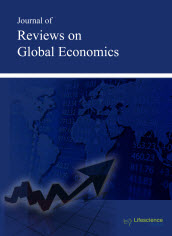jrge
Abstract - Pair-Wise Approach to Test the Regional Convergence Hypothesis in Mexico
|
|
Abstract: This paper assesses the gross domestic product (GDP) per capita convergence of the 32 Mexican States in the period 1940-2010 through the method proposed by Pesaran (2007), which is based on the convergence stochastic criterion. One of the main advantages of this method is not only on a model of leading economy, also on a pair-wise approach that considers all possible gap pairs of per capita logarithms of all the Mexican States analyzed in the sample. According to this method, all the differences or output gaps of the States must be stationary around a constant mean. Most results provide evidence against the hypothesis of convergence especially for the total sample from 1940 to 2010 and the first period from 1940 to 1985. However, mixed evidence of this hypothesis was observed in the second period from 1986 to 2010. Additionally, the test results applied to a set of States considered as the richest suggest these findings are not due to the unique behavior of these States. Keywords: Unit root, Panel data models, Pair-wise test, Economic growth, Stochastic convergence.Download Full Article |
Abstract - Inequality and Spatial Convergence in the Mexico City Metropolitan Area, 1989-2010
|
|
Abstract: The analysis of inequality and polarization patterns between by regions of a national economy is central to ascertaintheir possibilities of future economic development. In this work we study such patterns in municipalities and boroughs of Mexico City Metropolitan Area (Zona Metropolitana de la Ciudad de Mexico, ZMCM). The evolution of inequality and polarization in this important area of Mexico is studied with new proposals of measurement using spatially conditioned indexes and through a dynamic transition analysis. The results confirm that the territorial inequality has grown among the municipalities and boroughs that integrate the ZMCM. Moreover, this phenomenon coincides with an increase of the polarization characterized by the formation of four subgroups or convergence clubs. Keywords: Inequality, polarization, dynamic transition, Mexico City Metropolitan Area (ZMCM).Download Full Article |
Abstract - Spatial Interaction Regional Model for the Mexican Economy (SIRMME): A Special Case for Mexico City Metropolitan Area
|
|
Abstract: This paper analyzes empirically a macro model and a regional model to explain Mexico and Mexico City economies respectively. Typically, regional economic modeling considers either a top-down or bottom-up approach to model regional difference in economic growth. This paper shows results that explain regional difference in Mexico from the bottom-up through a special case that focuses on the spatial interaction between Mexico City -the main economic engine of Mexico- and the rest of the country during the period 2000-2010. Our results indicate that variables associated with human capital, internal migration, "creative class", micro-firms and spatial interaction among micro-regions were conditioning the differential growth between Mexico City and the whole country during the period 2000-2010. Likewise, we present econometric results of a typical macro model that explains economic growth in Mexico by different income effects on components of aggregate demand during the period 1993-2010. The purpose of both exercises is to motivate future research for the Mexican case to link macro components (such as export driven forces, Mexico´s dependency to the USA´s business cycle, loss of government spending, etc.) with their local counterparts such as agglomeration economies, human and creative capital stock, regional spillovers, natural resources, dynamic population, etc. to explain regional differential growth. Keywords: Spatial regional model, differential regional growth, simulation forecasting, Mexican economy, Mexico City Metropolitan Area.Download Full Article |
Abstract - Testing for Pro-Poorness of Growth through the Tax System: The Mexican Case
|
|
Abstract: This research provides a detailed examination of the redistributive effect achieved by the tax system including total taxes and cash transfers targeting the contributors and households in the period 2002-2008-2014 for the Mexican regions and the country. We measure the impact on income growth through the tax system according to each fiscal rules for the corresponding years using pre and post fiscal conditions. We answer the next question: considering the economic growth on per capita incomes in the Mexican states, will the impact of the Mexican tax system improve income distribution? That is, by all means pro-poor? Our methodology allows to detect if taxes and benefits can really induce an improvement of income growth on the regions captured by its wellbeing and economic growth conditions. We outlined relevant theoretical issues on public fiscal policies concerning this work and lastly, we proceed with an empirical application to develop some recommendations for the Mexican fiscal policy system. Keywords: Fiscal policy, pro-poor regional growth, redistribution, progressivity.Download Full Article |























